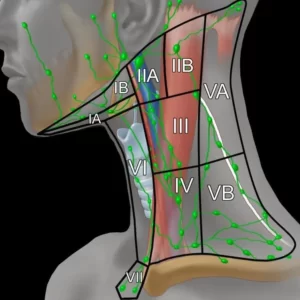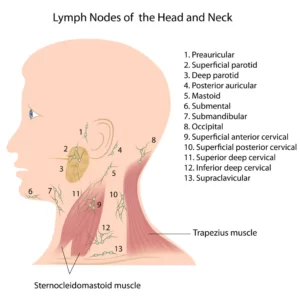Swollen Neck Cervical Lymph Nodes 101: Understanding Anatomy, Causes & Treatment
Home | Treatments | Head And Neck | Cervical Lymph Nodes – Cervical Lymphadenopathy
Cervical lymph nodes are small, bean-shaped structures located throughout the neck. These are an essential part of the immune system and play a crucial role in filtering and destroying harmful bacteria, viruses and fungi. However, when these enlarge and become swollen lymph nodes, it could indicate the presence of an an underlying medical condition known as cervical lymphadenopathy. In this article, we will explore the various aspects of swollen cervical lymph nodes and cervical lymphadenopathy, including their functions, causes, symptoms, diagnosis, treatment, and prevention.
What Are Cervical Lymph Nodes?
Cervical lymph nodes are a part of the lymphatic system, a network of tissues and organs that help fight infections and diseases. These nodes are located in the neck and are responsible for filtering the lymphatic fluid, also known as lymph, that flows through them. Lymph nodes are scattered throughout the body. They are part of the body’s immune system. These nodes help fight infection by producing special white blood cells. They also work by trapping bacteria, viruses, and cancer cells. Normally, lymph nodes cannot be felt unless they are swollen. Infection, usually by a virus, is the most common cause of swollen lymph nodes; other causes of swollen cervical lymph nodes include bacterial infection and cancer.
Cervical lymph nodes specifically refer to lymph nodes in the region of the head and neck, and are divided into two main groups, the superficial cervical lymph nodes located just beneath the skin, and the deep cervical lymph nodes located deep within the neck. These groups are located around large vessels in the neck, namely the internal jugular vein and the internal carotid artery; and an important nerve – the spinal accessory nerve. There are other groups of lymph nodes, such as axillary lymph nodes and inguinal lymph nodes, which are located in in the armpit and groin region respectively.
You may also come across the location of cervical nodes being described as being at different levels. These neck node levels are the same as described above, but are mainly used by healthcare professionals, and will be listed here as well for completeness.
What Are The Cervical Lymph Nodes Levels?
 There are six levels of cervical nodes, each with their own anatomic demarcation. These levels are numbered I to VI, from the most superficial (closest to the skin’s surface) to the deepest (closest to the spine).
There are six levels of cervical nodes, each with their own anatomic demarcation. These levels are numbered I to VI, from the most superficial (closest to the skin’s surface) to the deepest (closest to the spine).
Level I Lymph Nodes
Level I lymph nodes are located along the lower border of the mandible and include the submental and submandibular lymph nodes. These nodes drain the lower lip, mouth floor, tongue, sublingual and submandibular glands.
Level II Lymph Nodes
Level II lymph nodes are located along the upper third of the sternocleidomastoid muscle (SCM) and include the upper jugular group. They are split into Level IIA and IIB by the location of the spinal accessory nerve. These nodes drain the posterior nasal cavity, oropharynx, hypopharynx, nasopharynx, and thyroid gland.
Level III Lymph Nodes
Level III lymph nodes are located along the middle third of the SCM and include the middle jugular group. These nodes drain the tonsil, soft palate, and posterior pharyngeal wall.
Level IV Lymph Nodes
Level IV lymph nodes are located along the lower third of the SCM and include the lower jugular group. These nodes drain the supraglottic larynx, piriform sinus, and cervical esophagus.
Level V Lymph Nodes
Level V lymph nodes are also known as posterior triangle nodes. They are located in the posterior triangle of the neck and include the spinal accessory nodes (which are in close relation to the spinal accessory nerve). These nodes drain the posterior scalp, posterior neck, and anterior chest wall.
Level VI Lymph Nodes
Level VI lymph nodes are also known as anterior cervical lymph nodes, and are located along the midline of the neck. They include the pretracheal, paratracheal, prelaryngeal and recurrent laryngeal nodes. These nodes drain the thyroid gland, larynx, and trachea.
Understanding the levels of cervical lymph nodes and their anatomic demarcation is important for healthcare professionals when evaluating patients with cervical lymphadenopathy, as it can help determine the potential cause of lymph node enlargement and the appropriate treatment options.
Causes Of Cervical Lymphadenopathy
 Causes of cervical lymphadenopathy are usually viral or bacterial infection, which can include:
Causes of cervical lymphadenopathy are usually viral or bacterial infection, which can include:
- Infection of the tonsils and adenoids
- Upper respiratory tract infections (URTI)
- Severe ear infection
- Other viral infections
There are also other more serious conditions or infections that can cause swollen cervical lymph nodes. Fortunately, these are rare, and include:
- Tuberculosis
- Lymphoma
- Fungal Infections
- Head and Neck Cancers with cervical lymph node metastasis
- Cancers of the thyroid gland
- Squamous cell carcinoma of the head and neck region
Symptoms Of Swollen Cervical Lymph Nodes
The most noticeable symptom of swollen lymph nodes is the enlargement of the cervical lymph nodes. The enlarged nodes can be felt as small, hard, and painless lumps beneath the skin. They may be painless swelling, or they may be painful. Depending on the underlying cause, cervical lymphadenopathy can also present with other symptoms such as:
- Fever
- Fatigue
- Night sweats
- Weight loss
- Sore throat
- Skin rashes
- Joint pain
Diagnosis Of Cervical Lymphadenopathy
To diagnose a swollen cervical lymph node, a medical history, as well as as a physical examination will be performed. The location, size, and texture of the enlarged lymph nodes will then be determined. Additional tests such as blood tests, imaging tests, and a biopsy may be performed to determine the underlying cause of the lymph node enlargement.
How Are Swollen Cervical Lymph Nodes Investigated?
Flexible Nasoendoscopy
In the majority of cases of swollen lymph nodes with no obvious cause, flexible nasoendoscopy is performed. This involves the insertion of a small, thin tube into the nostrils to assess the nasal cavity and throat for the presence of lesions which may be related to cervical lymphadenopathy.
Imaging
Imaging is frequently requested in order to asses the site and extent of cervical lymph node swelling. Imaging may also pick up other abnormalities which may be causing or are related to cervical lymphadenopathy. This may take the form of ultrasound examinations, computed tomography (CAT) scans, or Magnetic resonance imaging (MRI) scans.
Blood Tests
Routine blood tests are run to look for a high white blood count that would suggest a bacterial infection. Other more specific blood tests may be run if other conditions are suspected.
Biopsy
Lymph nodes can be biopsied in the following ways:
Fine needle aspiration (FNA)
A thin needle with a hollow tube is inserted into the lesion to remove fluid and sample cells for testing. A fine-needle aspiration is usually completed within 10-15 minutes, and there is little to no patient down time. This is usually the first type of biopsy performed.
Core needle biopsy
This biopsy is similar to a fine needle aspiration, except a larger needle is used. With the larger hollow center, a small block of tissue can be removed for testing, allowing more information to be collected than with fluid or cells. Local anesthesia is typically utilized, and the procedure lasts approximately 15-30 minutes.
Open biopsy
A small incision is made in order to remove part or all of the cervical lymph node. The procedure is most often performed with local anesthesia applied to the biopsy site, but general anesthesia may also be used in cases where it is desirable for the patient to be sleeping. An open biopsy usually takes less than an hour, and afterward, your surgeon will close the site with sutures and apply a bandage. The incision takes approximately 10-14 days to heal, during which strenuous activity should be avoided. Open biopsies are only performed if FNA biopsy or core needle biopsies are inconclusive; or if the patient’s medical condition necessitates it.
How Is Cervical Lymphadenopathy Treated?
Cervical lymphadenopathy should be investigated and treated if it has been present for a prolonged duration, or if there is any concern about an underlying malignancy. In cases where the lymph node enlargement is due to an infection, antibiotics or antiviral medications may be prescribed. In cases where the lymph node enlargement is due to an inflammatory condition, corticosteroids or other immunosuppressive medications may be used to reduce inflammation. In cases where the lymph node enlargement is due to cancer, treatment may involve neck surgery, chemotherapy, radiation therapy, or a combination of these treatments.
Conclusion
Cervical lymphadenopathy is a condition where the cervical lymph nodes become enlarged due to an underlying medical condition. While it is not a disease in itself, it can indicate a range of medical conditions, including infections, inflammatory conditions, and cancer. The symptoms include swollen lymph nodes, fever, fatigue, and weight loss. The treatment of these swollen nodes depends on the underlying cause, and prevention involves taking measures to prevent these.
If you notice any unusual lumps or bumps in the neck, it is important to seek medical attention promptly.
Frequently Asked Questions
Can Stress Cause Cervical Lymphadenopathy?
Stress alone does not cause cervical lymphadenopathy. However, stress can weaken the immune system, making it more susceptible to infections that can cause this condition.
Can Allergies Cause Cervical Lymphadenopathy?
What is Pediatric Cervical Lymphadenopathy?
It is a condition where swollen lymph nodes occur in chlidren. These can be relatively common, as children tend to get upper respiratory tract infections frequently. However, if they persist, they should be evaluated by a medical professional.
Can Enlarged Cervical Lymph Nodes Be A Sign Of Cancer?
Yes, cervical lymphadenopathy can be a sign of cancer, particularly lymphomas and head and neck tumors. It is important to seek medical attention if you notice any unusual lumps or bumps in the neck region.
Can Swollen Lymph Nodes Be Painful?
In most cases, cervical lymphadenopathy is not painful. However, in cases where they are acutely infected, the enlarged lymph nodes can cause discomfort or pain.
Is Cervical Lymphadenopathy Contagious?
No, cervical lymphadenopathy itself is not contagious. However, the underlying infections that can cause cervical lymphadenopathy may be contagious.
When Should I See A Doctor If I Have Enlarged Lymph Nodes?
You should see a doctor as soon as possible if you notice any unusual lumps or bumps in the neck, especially if they are accompanied by other symptoms such as fever, fatigue, or night sweats.

Medically Reviewed By:
Dr Leslie Koh
M.B;B.S. (Singapore), MRCS (ENT) Edinburgh, M. Med (ORL), FAMS
Table Of Content
Conditions We Treat
- Thyroid nodules
- Cancer of the Thyroid
- Salivary Gland lumps
- Salivary Gland and/or Salivary Duct Stones
- Enlarged Cervical Lymph Nodes
- Cancers of the Head and Neck Region
- Nasopharyngeal Cancer (NPC)
- Lesions in the Mouth & Oral Cavity
Our Treatments
- Hemi / Total Thyroidectomy
- Salivary gland removal (submandibular / parotid gland)
- Removal of salivary duct stones
- Excision of Cervical Lymph Nodes
- Excision of Mouth & Oral Cavity Lesions


